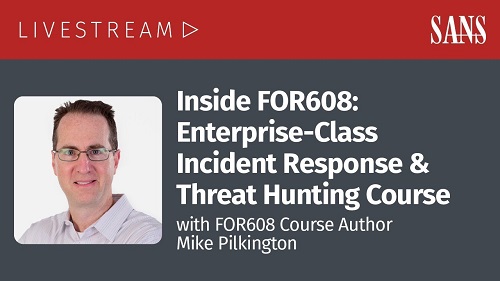
SANS FOR608: Enterprise-Class Incident Response & Threat Hunting (2022) – PDF
English | Tutorial | Size: 93.94 MB
Enterprises today have thousands; maybe even hundreds of thousands – of systems ranging from desktops to servers, from on-site to the cloud. Although geographic location and network size have not deterred attackers in breaching their victims, these factors present unique challenges in how organizations can successfully detect and respond to security incidents. Our experience has shown that when sizeable organizations suffer a breach, the attackers seldom compromise one or two systems. Without the proper tools and methodologies, security teams will always find themselves playing catch-up, and the attacker will continue to achieve success.
FOR608: Enterprise-Class Incident Response & Threat Hunting focuses on identifying and responding to incidents too large to focus on individual machines. The concepts are similar: gathering, analyzing, and making decisions based on information from hundreds of machines. This requires the ability to automate and the ability to quickly focus on the right information for analysis. By using example tools built to operate at enterprise-class scale, students will learn the techniques to collect focused data for incident response and threat hunting. Students will then dig into analysis methodologies, learning multiple approaches to understand attacker movement and activity across hosts of varying functions and operating systems by using timeline, graphing, structured, and unstructured analysis techniques.
FOR608: Enterprise-Class Incident Response & Threat Hunting will teach you to:
Understand when incident response requires in-depth host interrogation or light-weight mass collection
Deploy collaboration and analysis platforms that allow teams to work across rooms, states, or countries simultaneously
Collect host- and cloud-based forensic data from large environments
Discuss best practices for responding to Azure, M365, and AWS cloud platforms
Learn analysis techniques for responding to Linux and Mac operating systems
Analyze containerized microservices such as Docker containers
Correlate and analyze data across multiple data types and machines using a myriad of analysis techniques
Conduct analysis of structured and unstructured data to identify attacker behavior.
Enrich collected data to identify additional indicators of compromise
Develop IOC signatures and analytics to expand searching capabilities and enable rapid detection of similar incidents in the future
Track incidents and indicators from beginning to end using built-for-purpose incident response engagement tooling.
Business Takeaways
Reduce financial and reputational impact of a breach by more efficiently and precisely managing the response
Learn IR management techniques that optimize resource usage during an investigation
Deploy collaboration and analysis platforms that allow teams to work across rooms, states, or countries simultaneously
Understand and hunt for techniques attackers use to hide from EDR and application control tools on Windows systems
Learn analysis techniques for responding to compromised Linux and macOS systems
Be able to respond and analyze containerized microservices such as Docker containers
Discuss best practices for responding to the most popular cloud environments – specifically Microsoft365/AzureAD, and AWS.

RAPIDGATOR
rapidgator.net/file/f4409e9098fcd8cb0c03cb5e40ca49f8/SANS_FOR608.rar.html
NITROFLARE
nitroflare.com/view/F6F50CD57253089/SANS_FOR608.rar